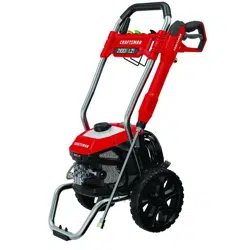Loading ...
Loading ...
Loading ...

7
English
Test Ground-Fault Circuit-Interrupter
(GFCI) Before Each Use (FIg. A)
This pressure washer is provided with a ground-fault circuit-
interrupter (GFCI) built into the plug of the power-supply
cord. This device provides additional protection from the
risk of electricshock.
1. Plug the Ground Fault Circuit Interrupter (GFCI) into a
working grounded outlet.
2. The indicator at the top of the GFCI should turn green
when product is ready to use.
3. Press the “TEST” button (bottom). The green indicator
should disappear.
4. Press “RESET” button for use. Do not use if the above
test fails.
Fig.M
43
unprotected skin, eyes, or with any pets or animals.
Serious injury willoccur.
CAUTION: Before operation:
- Connect the water supply to the pressure washer . For
instructions on connecting the water supply to the
pressure washer, please refer to Attaching garden
hose under Assembly andAdjustments.
- Connect the High pressure hose to the pressure washer
and the pressure wand. For instructions on connecting
the High pressure hose to the pressure washer and
pressure wand, please refer to Attaching high
Pressure hose under Assembly andAdjustments.
Preparing Spray Handle (Fig. A)
iMPORTAnT: Before turning on the pressure washer unit,
disengage the trigger lock-off
5
and squeeze the trigger
6
.
Hold the trigger for 30 seconds to purge the system of air. If
air is still found in the water stream, continue to run water
through the sprayhandle.
1. Disengage the trigger lock-off
5
.
2. Squeeze the trigger
6
.
Cleaning a Surface (Fig. A, N)
• To start the pressure washer, rotate the ON/OFF switch
8
to the ON position.
• The best angle for spraying water against a cleaning
surface is 45°. Spraying head on tends to cause dirt
particles to imbed in the surface. When working on
vertical surfaces, it is best to apply detergent starting at
the bottom and working upwards which will prevent
the detergent from sliding down and causing streaks.
To disengage the spray handle, release thetrigger.
nOTE: Excessive pump pressure may be the result of a
clogged nozzle or brass coupling. Always turn OFF the
pressure washer unit and unplug the unit before attempting
to unclog a nozzle or brasscoupler.
Fig.N
8
Moving the Pressure Washer (Fig. A)
1. Turn OFF the pressure washer unit
7
by rotating the
ON/OFF switch
8
to the OFF position and then turn
OFF the watersupply.
2. Point the spray wand
2
in a safe direction and pull the
trigger
6
to release remaining waterpressure.
3. When the spray wand is completely empty, pull the
pressure washer by the handle
9
.
Proper Hand Position (Fig. M)
WARNING: To reduce the risk of serious personal
injury, ALWAYS use proper hand position as shown.
WARNING: To reduce the risk of serious personal
injury, ALWAYS hold securely in anticipation of a
suddenreaction.
Proper hand position requires one hand on the spray handle
grip
4
and the other hand on the spray handle
3
.
OPERATION
WARNING: To reduce the risk of serious personal
injury, turn unit OFF and disconnect it from
power source before making any adjustments or
removing/installing attachments or accessories.
An accidental start-up can causeinjury.
Pressure Washing
Preparing Surface for Cleaning
• Remove objects from the area which could create a
hazard such as children's toys or outdoor furniture.
• Insure that all doors and windows are closed tight.
Protect all plants and trees in the adjacent area with a
drop cloth ensuring that they will not be harmed by any
overspray.
• Pre-rinse cleaning area with fresh water.
• Use only detergents formulated for pressure washers.
• Always test detergent in an inconspicuous area before use.
Preparing Pressure Washer Unit for Use (Fig. A)
DANGER: Risk of fluid injection and laceration.
When using the high-pressure setting, DO NOT allow
the high-pressure spray to come in contact with
Loading ...
Loading ...
Loading ...
